Fix: DISM Error ‘WOF Driver Encountered a Corruption’ on Windows 10/11
Some Windows 11 users report that when they attempt to run a DISM scan to fix a Windows Update issue, the scan gets interrupted by the ‘The WOF driver encountered corruption in the compressed file’s Resource Table’ error. This issue is confirmed to appear on both Windows 10 and Windows 11.
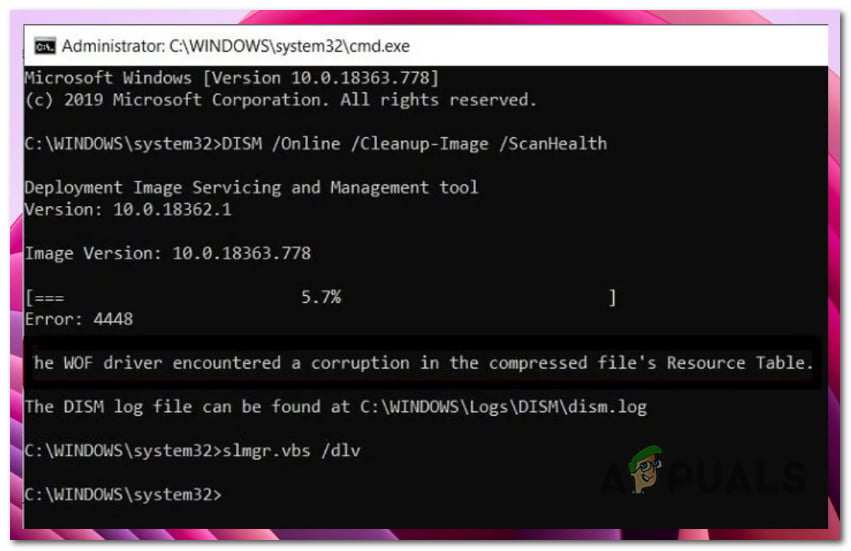
T7his issue can have multiple potential root causes. Here’s a short list of culprits you should investigate when troubleshooting the ‘The WOF driver encountered corruption in the compressed file’s Resource Table’ error on Windows 10 and Windows 11:
- System File corruption – If the DISM scan is not functioning as it should and throws the error each time you initiate the scan, your first action should be to deploy a System File Checker (SFC) scan to attempt to treat the issue locally. You can also try deploying clean install or repair install procedures or going for an in-place upgrade.
- Common WU Inconsistency – If the SFC scan above didn’t resolve the problem for you, you should look into any potential WU component issues. The problem should be resolved by running the Windows Update Troubleshooter and applying the recommended patch.
- Corrupted WU component – Most of the time, this type of issue is caused by one or more WU (Windows Update) components that are now dormant (i.e., neither open nor closed). If this is the case, you may fix the problem by restarting every WU component involved in the upgrade process.
- Recent system change – Following a recent system change, you may anticipate dealing with this problem, according to multiple affected individuals (like installing an infrastructure update, a driver update, or a cleanup procedure performed by an antivirus). You may probably completely prevent the issue and fix the error by rolling your PC back to a working condition using System Restore to go back in time.
- Corrupted temporary files – If you haven’t already, you should try using the Disk Cleanup tool to remove any unwanted DirectX Shader Cache, Delivery Optimization Files, Temporary Internet Files, or Downloaded Program Files that can cause Windows 11 to malfunction during DISM scans. If the issue only recently began to manifest, follow the steps below to conduct a Disk Cleanup scan and delete all redundant system files.
Now that we have gone over every potential reason why you might experience this problem let’s go over a series of confirmed fixes that other Windows 10 and Windows 11 users have successfully used to get rid of the ‘The WOF driver encountered corruption in the compressed file’s Resource Table’ error when running a DISM scan.
1. Perform an SFC Scan
If the DISM scan is not functioning as it should and it throws the ‘The WOF driver encountered corruption in the compressed file’s Resource Table’ error each time you initiate the scan, your first action should be to deploy a System File Checker (SFC) scan to attempt to treat the issue locally.
Note: Unlike a DISM scan, an SFC scan doesn’t rely on an Internet connection to fix or replace system file corruption. Instead, it uses a locally stored cache of Windows files. Once you initiate this procedure, it’s important to avoid closing the elevated CMD window prematurely.
Follow the instructions below to initiate an SFC scan from an elevated CMD prompt:
- To open the Run dialog box, press the Windows key + R.
- When the dialog box displays, type “cmd” and press the CTRL key while simultaneously holding down the Shift key and the Enter key to start an administrator Command Prompt.
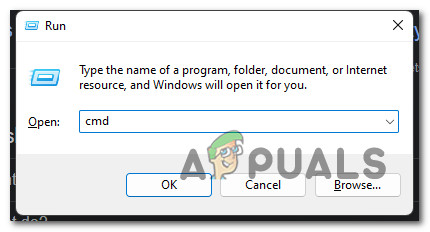
Open a CMD command - When the User Account Control asks you to enable administrator access, choose Yes.
- At the elevated CMD prompt, type the following command and press Enter to start an SFC scan:
sfc /scannow
Note: System File Checker only functions locally and doesn’t need an active internet connection. To work successfully, it employs a locally cached archive of backup system files to swap out any faulty files with their undamaged equivalents.
- After the scan is complete, reboot your PC and see if the problem is now fixed.
If you’re still experiencing the same ‘The WOF driver encountered corruption in the compressed file’s Resource Table’ error, move down to the next method below.
2. Run the Windows Update Troubleshooter
If the SFC scan above didn’t resolve the problem for you, you should look into any potential WU component issues. Many afflicted users that began to see the message “The WOF driver experienced corruption in the compressed file’s Resource Table” following the installation of a scheduled Windows update have confirmed this.
There is probably a Microsoft repair plan in the Windows Update Troubleshooter that you may use to fix the issue. The problem should be resolved by running the Windows Update Troubleshooter and applying the recommended patch.
Remember that Windows 11’s troubleshooting tool is far more thorough than previous releases. If an identifiable issue is discovered, Microsoft has included hundreds of new automated repair options that may be immediately deployed to fix Windows Update’s functionality.
Follow these steps to utilize the Windows Update Troubleshooter and apply the suggested fix:
- Press the Windows key + R to launch the Run dialog box and try to repair the Windows Update component.
- In the text field of the dialog box that just opened, type “control” and hit Enter to launch the Control Panel interface.
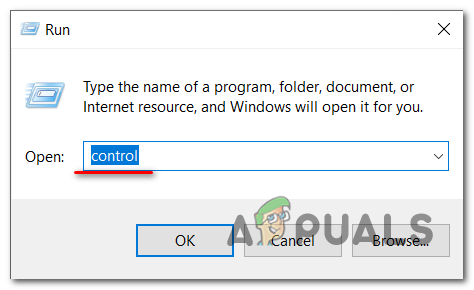
Access the Control menu Note: Select Yes if the User Account Control dialog requests admin access.
- Once in the Control Panel window, type “troubleshoot” into the search field.
- Select every category under Troubleshooting in the results box.
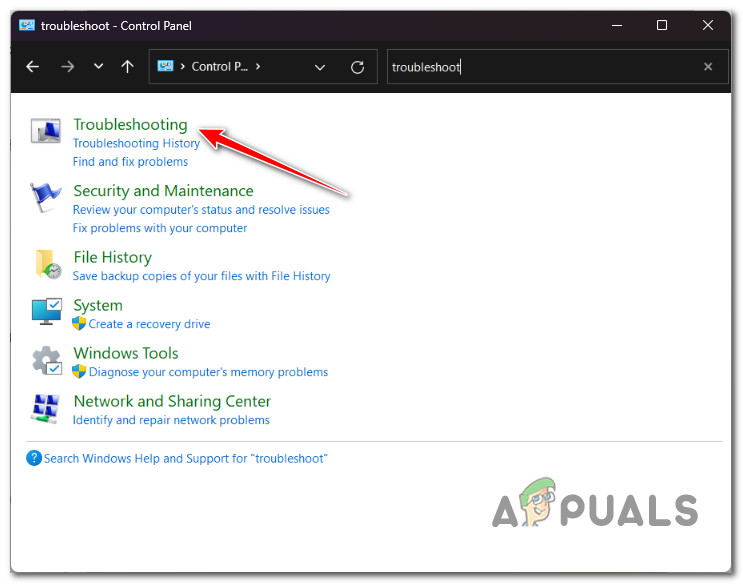
Access the Troubleshoot tab - After selecting the Troubleshooting tab, go to System and Security and choose Fix problems with Windows Updates.
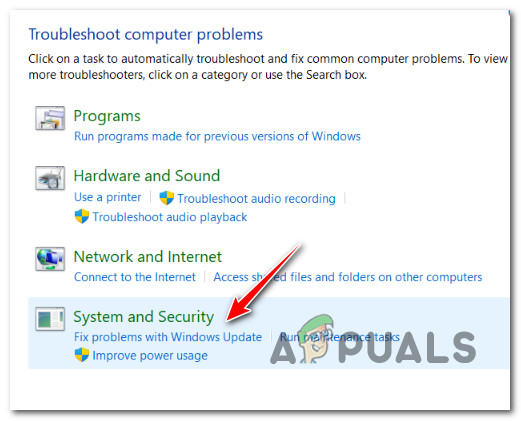
Access the System & Security - After choosing Next, hold off until the preliminary analysis is finished.
- If the Windows Update Troubleshooter has found a feasible repair, click Apply this Fix to apply it to the current situation.

Apply this fix Note: The troubleshooter may recommend certain manual procedures along with some recommended fixes.
- After the repair has been properly implemented, restart your computer to determine whether the issue has been resolved.
Go to the next procedure below if the problem is still present.
3. Reset every WU component
If the following solution doesn’t work for you, you’re probably dealing with a chronic problem that affects the Windows Update component.
If the aforementioned traditional methods didn’t work to fix the “The WOF driver discovered corruption in the compressed file’s Resource Table” error, use the same repair approaches to reset every Windows Update component that could be causing issues with your next Windows updates.
Most of the time, this type of issue is caused by one or more WU (Windows Update) components that are now dormant (i.e., neither open nor closed). If this is the case, you may fix the problem by restarting every WU component involved in the upgrade process.
Follow these procedures to reset the whole WU component from an elevated Command Prompt:
- Press the Windows key + R to open the Run dialog box. Then, type “cmd” into the text box and press Ctrl + Shift + Enter to open an elevated Command Prompt.
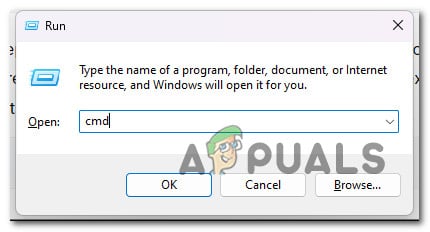
CMD Note: When the UAC prompts you to grant administrator access, choose Yes (User Account Control).
- Type the commands at the elevated Command Prompt in the following order, hitting Enter after each command to stop all WU-related services.
net stop wuauserv net stop cryptSvc net stop bits net stop msiserver
Note: Please be aware that by following these instructions, the BITS Service, the Cryptographic Service, the MSI Installer, and the Windows Update Service will all be terminated.
- After all relevant services have been stopped, execute the following commands to remove and rename the SoftwareDistribution and Catroot2 directories:
ren C:WindowsSystem32catroot2 Catroot2.old ren C:WindowsSoftwareDistribution SoftwareDistribution.old
Note: It should be noted that these folders are responsible for keeping the WU component’s updated files on hand. If you rename these folders, your OS will be compelled to create new, damage-free copies that are not affected by corruption.
- Use the following commands to reactivate the services we had previously deactivated after the directories have been cleaned up:
net start wuauserv net start cryptSvc net start bits net start msiserver
- Restart your computer when it has finished rebooting to see if the issue has been resolved.
If the issue persists after successfully refreshing every Windows Update component, scroll down to the next suggested fix below.
4. Use System Restore
Following a recent system change, you may anticipate dealing with this problem, according to multiple affected individuals (like installing an infrastructure update, a driver update, or a cleanup procedure performed by an antivirus).
You may probably completely prevent the issue and fix the error by rolling your PC back to a working condition using System Restore to go back in time.
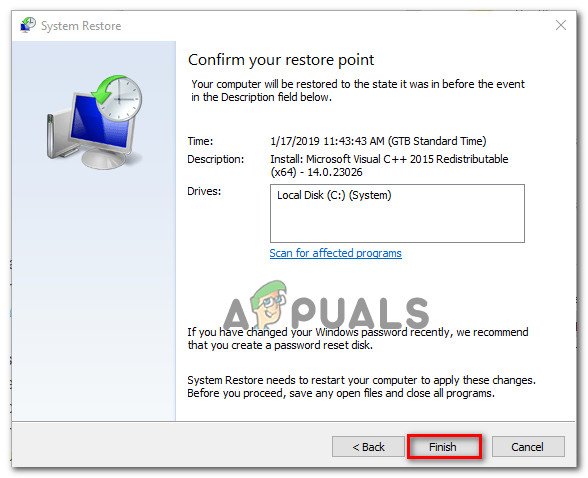
Important: Note that carrying out this action would undo all adjustments made following the creation of the system restore point. Everything will be gone, including all installed applications, adjusted system preferences, etc.
If you want to use this specific cure while being aware of the risks, follow the directions in this article.
Choose the following approach if you don’t have a workable restore point or if this method didn’t fix the issue in your case.
5. Deploy a Disk Cleanup
If you haven’t already, you should try using the Disk Cleanup tool to remove any unwanted DirectX Shader Cache, Delivery Optimization Files, Temporary Internet Files, or Downloaded Program Files that can cause Windows 11 to malfunction during DISM scans.
If the issue only recently began to manifest, follow the steps below to conduct a Disk Cleanup scan and delete all superfluous system files:
Before executing the steps below, be sure no resource-intensive tasks are currently running.
Here’s what you need to do to deploy a Disk Cleanup scan:
- To bring up the Run dialog box, press the Windows key + R. After that, enter “cleanmgr” into the text field to launch the Disk Cleanup tool.
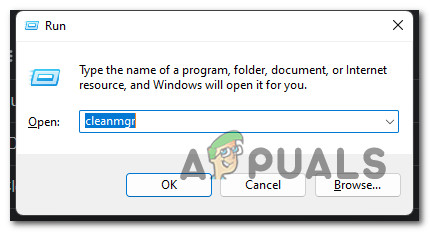
Open the Disk Cleanup utility - Click Yes to allow administrator access when the User Account Control window appears.
- Make sure to choose the OS (Windows) drive from the Drives drop-down option in the initial Disk Cleanup application.
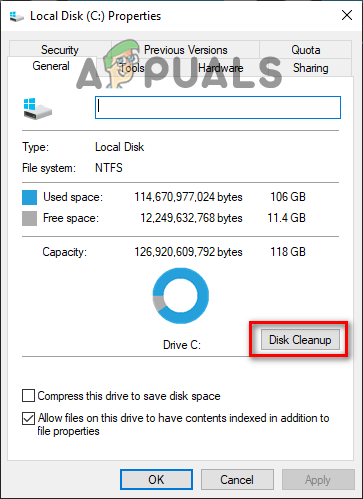
Performing a disk cleanup Note: A conventional and OS drive may be distinguished from one another by looking for the Windows icon.
- Once you’re on the Disk Cleanup page, make sure the following options are chosen from the box labeled Files to Delete:
Downloaded Program Files Temporary Internet Files Direct Sharder cache Delivery Optimization Files
- After choosing each file type above, select Clean up system files.
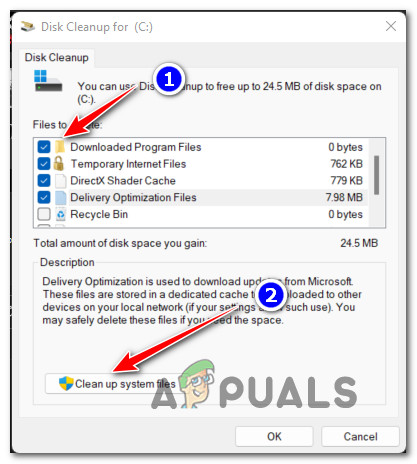
Cleaning up temp files - Click Yes to enable admin access when the User Account Control window appears.
- After the procedure is finished, reboot your computer and check whether the ‘The WOF driver encountered corruption in the compressed file’s Resource Table’ error is now fixed.
Continue to the next probable solution below if you still have the same problem.
6. Perform a clean install or repair install
If none of the methods mentioned so far have assisted you in fixing the WOF error, you may conclude that your issue is the consequence of a system corruption issue that cannot be fixed in the conventional manner (with an SFC scan).
Other Windows users who had a similar issue said that the issue was fixed once they updated every Windows component. This may be achieved via a clean install or an in-place fix (repair install).
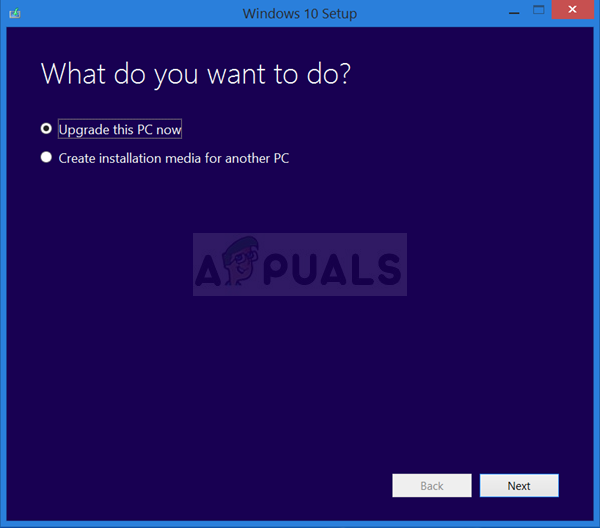
The main drawback of a clean install is that you can’t store your stuff (apps, games, personal media, etc.) unless you back them up.
On the other side, the major advantage of selecting a repair install is that you can keep all your personal information, including applications, games, personal media, and even certain user preferences. But the procedure takes a little longer.
7. Perform an in-place upgrade (Windows 11 only)
The absolute last resort if the “The WOF driver found corruption in the compressed file’s Resource Table” problem is still occurring is to perform an in-place upgrade of Windows 11.
Because it takes the most time and work, this is the last technique covered in this tutorial.
Nevertheless, many Windows users who have gone through this have discovered that this approach successfully resolves their issues.
You will effectively avoid the local component utilized to update your Windows version if you choose this path, so consider that. The disadvantage of this approach is that it will get you around the problem rather than at its root.
Important: To guarantee that you remove any damaged files, we highly advise you to back up your important data to a secure location and reset all your computer’s settings.
Here’s how to use the Windows Install assistant to do an in-place upgrade on your computer:
Note: The instructions below will only work on Windows 11.
- Open your default browser and navigate to the official Windows 11 download page.
- When you have arrived at the correct page, scroll down to the Download Windows 11 Disk Image (ISO) section and click the Select Download button to select Windows 11 from the list of possibilities.
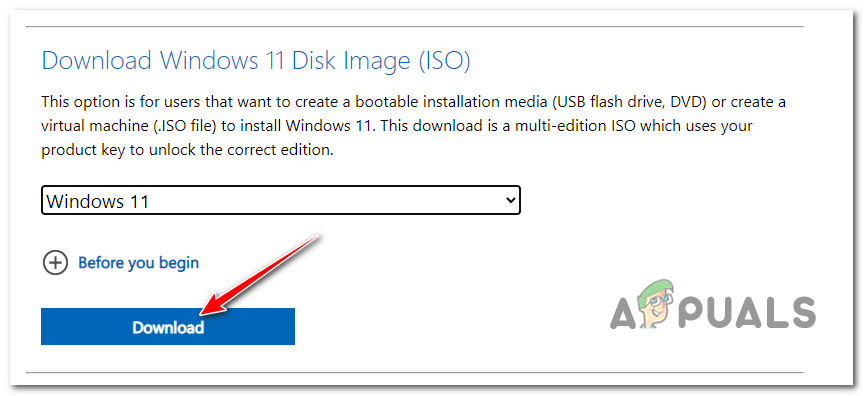
Download Windows 11 iso - Next, choose Download; do not register your selection just yet.
- Use the drop-down box from the newly shown question to select your preferred language before clicking Confirm.
- Click the newly-appeared Windows 11 English ISO button to complete the download.
Note: Please remember that this link will no longer be available when you click the download button after 24 hours. - To mount the ISO locally, simply double-click it when it has finished downloading locally.
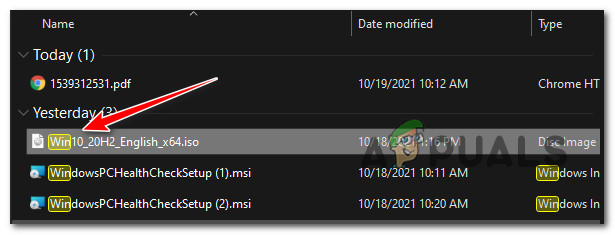
Access the Windows 11 ISO Note: There is no need to use any 3rd party software, such as Daemon Tools, to mount this ISO because every current version of Windows includes the native capability for mounting ISO files.
- Open File Explorer and double-click the newly formed virtual drive after the ISO has been mounted locally.
- Once you’ve reached the root directory of the Windows 11 ISO, double-click setup.exe.
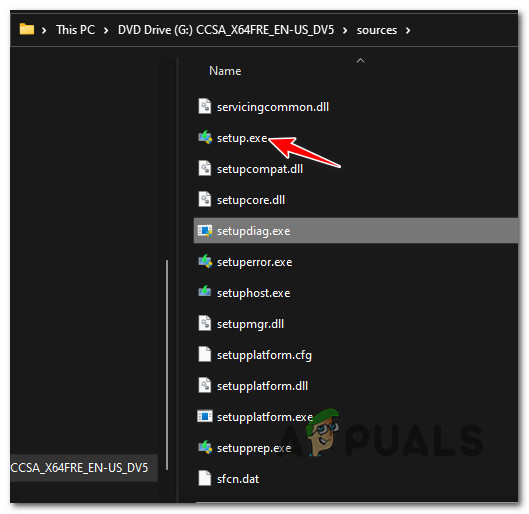
Accessing the Setup Screen Note: When the User Account Control dialog box appears, choose Yes.
- Select Download upgrades, drivers, and extra features (recommended) when you reach the Windows 11 Setup page. Then, follow the on-screen instructions to complete the Windows 11 updates that are pending.




